Optimization of Polyacrylic Acid Coating on Graphene Oxide-Functionalized Reverse-Osmosis Membrane Using UV Radiation through Response Surface Methodology
Abstract
:1. Introduction
2. Materials and Methods
2.1. Materials
2.2. Surface Modification by UV-Grafting
2.3. Separation Experiments
2.4. Inorganic Scaling Studies
2.5. Membrane Surface Characterization
2.6. Study Design
3. Results and Discussion
3.1. Effect of Acrylic Acid Concentration
3.2. Effect of UV Radiation Times
3.3. Response Surface Methodology (RSM)
3.4. Process Optimization and Experimental Validation
3.5. Characterization: Property, Morphology, Composition
3.5.1. Membrane Permeation Properties
3.5.2. Membrane Surface Morphology and Functional Group Analysis
3.6. Inorganic Fouling Test
4. Conclusions
Author Contributions
Funding
Data Availability Statement
Acknowledgments
Conflicts of Interest
References
- Bahar, O.U. Membrane autopsy study to characterize fouling type of RO membrane used in an industrial zone wastewater reuse plant. Desalination 2022, 529, 115648. [Google Scholar]
- Wang, J.; Li, S.; Guan, Y.; Zhu, C.; Gong, G.; Hu, Y. Novel RO membranes fabricated by grafting sulfonamide group: Improving water permeability, fouling resistance and chlorine resistant performance. J. Membr. Sci. 2022, 641, 119919. [Google Scholar] [CrossRef]
- Park, H.M.; Yoo, J.; Lee, Y.T. Improved fouling resistance for RO membranes by a surface modification method. J. Ind. Eng. Chem. 2019, 76, 344–354. [Google Scholar] [CrossRef]
- Gu, Q.A.; Liu, L.; Wang, Y.; Yu, C. Surface modification of polyamide reverse osmosis membranes with small-molecule zwitterions for enhanced fouling resistance: A molecular simulation study. Phys. Chem. Chem. Phys. 2021, 23, 6623–6631. [Google Scholar] [CrossRef]
- Saleem, H.; Zaidi, S.J. Nanoparticles in reverse osmosis membranes for desalination: A state-of-the-art review. Desalination 2020, 475, 114171. [Google Scholar] [CrossRef]
- Safarpour, M.; Khataee, A.; Vatanpour, V. Thin-film nanocomposite reverse osmosis membrane modified by reduced graphene oxide/TiO2 with improved desalination performance. J. Membr. Sci. 2015, 489, 43–54. [Google Scholar] [CrossRef]
- Ashfaq, M.Y.; Al-Ghouti, M.A.; Zouari, N. Functionalization of reverse osmosis membrane with graphene oxide and polyacrylic acid to control biofouling and mineral scaling. Sci. Total Environ. 2020, 736, 139500. [Google Scholar] [CrossRef]
- Ansari, A.; Pena-Bahamonde, J.; Wang, M.; Devin, L.; Shaffer, D.L.; Hu, Y.; Rodrigues, D.F. Polyacrylic acid-brushes tethered to graphene oxide membrane coating for scaling and biofouling mitigation on reverse osmosis membranes. J. Membr. Sci. 2021, 630, 119308. [Google Scholar] [CrossRef]
- Baih, M.A.; Saffaj, H.; Aziz, K.; Bakka, A.; El Baraka, N.; Zidouh, H.; Mamouni, R.; Saffaj, N. Statistical optimization of the elaboration of ceramic membrane support using Plackett-Burman and response surface methodology. Mater. Today Proc. 2021, 52, 128–136. [Google Scholar] [CrossRef]
- Yan, X.; Wang, G.; Ma, C.; Li, J.; Cheng, S.; Yang, C.; Chen, L. Effects of pollutants in alkali/surfactant/polymer (ASP) flooding oilfield wastewater on membrane fouling in direct contact membrane distillation by response surface methodology. Chemosphere 2021, 282, 131130. [Google Scholar] [CrossRef]
- Chung, Y.T.; Ng, L.Y.; Mohammad, A.W. Sulfonated-polysulfone membrane surface modification by employing methacrylic acid through UV-grafting: Optimization through response surface methodology approach. J. Ind. Eng. Chem. 2014, 20, 1549–1557. [Google Scholar] [CrossRef]
- Razali, N.F.; Mohammad, A.W.; Hilal, N.; Leo, C.P.; Alam, J. Optimisation of polyethersulfone/polyaniline blended membranes using response surface methodology approach. Desalination 2013, 311, 182–191. [Google Scholar] [CrossRef]
- Hasanzadeh, R.; Azdast, T.; Mojaver, M.; Park, C.B. High-efficiency and low-pollutant waste polystyrene and waste polystyrene foam gasification: Comprehensive comparison analysis, multi-objective optimization and multi-criteria decision analysis. Fuel 2022, 316, 123362. [Google Scholar] [CrossRef]
- Hasanzadeh, R.; Mojaver, M.; Azdast, T.; Park, C.B. A novel systematic multi-objective optimization to achieve high-efficiency and low-emission waste polymeric foam gasification using response surface methodology and TOPSIS method. Chem. Eng. J. 2022, 430, 132958. [Google Scholar] [CrossRef]
- Tosto, C.; Tirillò, J.; Sarasini, F.; Sergi, C.; Cicala, G. Fused Deposition Modeling Parameter Optimization for Cost-Effective Metal Part Printing. Polymers 2022, 14, 3264. [Google Scholar] [CrossRef]
- Wu, W.; He, X.; Li, B.; Shan, Z. An Effective Shrinkage Control Method for Tooth Profile Accuracy Improvement of Micro-Injection-Molded Small-Module Plastic Gears. Polymers 2022, 14, 3114. [Google Scholar] [CrossRef]
- Mojaver, P.; Khalilarya, S.; Chitsaz, A. Multi-objective optimization and decision analysis of a system based on biomass fueled SOFC using couple method of entropy/VIKOR. Energy Convers. Manag. 2020, 203, 112260. [Google Scholar] [CrossRef]
- Abidi, J.; Clematis, D.; Samet, Y.; Delucchi, M.; Cademartori, D.; Panizza, M. Influence of anode material and chlorides in the new-gen solid polymer electrolyte cell for electrochemical oxidation–Optimization of Chloroxylenol degradation with response surface methodology. J. Electroanal. Chem. 2022, 920, 116584. [Google Scholar] [CrossRef]
- Bhavani, Y.; Babu, N.C.; Kumar, K.U. Decolorisation of Congo red synthetic solution using Fe doped ZnO nano particles and optimization using response surface methodology. Mater. Today Proc. 2022, in press. [CrossRef]
- Mendonça, M.C.P.; Rodrigues, N.P.; de Jesus, M.P.; Amorim, M.J.B. Graphene-based nanomaterials in soil: Ecotoxicity assessment using Enchytraeus crypticus reduced full life cycle. Nanomaterials 2019, 9, 858. [Google Scholar] [CrossRef] [PubMed]
- Clemente, Z.; Silva, G.H.; Nunes, M.C.S.; Martinez, D.S.T.; Maurer-Morelli, C.V.; Thomaz, A.A.; Castro, V.L.S. Exploring the mechanisms of graphene oxide behavioral and morphological changes in zebrafish. Environ. Sci. Pollut. Res. 2019, 26, 30508–30523. [Google Scholar] [CrossRef] [PubMed]
- Ashfaq, M.Y.; Al-Ghouti, M.A.; Zouari, N. Functionalization of reverse osmosis membrane with graphene oxide to reduce both membrane scaling and biofouling. Carbon 2020, 166, 374–387. [Google Scholar] [CrossRef]
- Perreault, F.; Tousley, M.E.; Elimelech, M. Thin-film composite polyamide membranes functionalized with biocidal graphene oxide nanosheets. Environ. Sci. Technol. Lett. 2014, 1, 71–76. [Google Scholar] [CrossRef]
- Suresh, D.; Goh, P.S.; Ismail, A.F.; Hilal, N. Surface Design of Liquid Separation Membrane through Graft Polymerization: A State of the Art Review. Membranes 2021, 11, 832. [Google Scholar] [CrossRef] [PubMed]
- Homayoonfal, M.; Akbari, A.; Mehrnia, M.R. Preparation of polysulfone nanofiltration membranes by UV-assisted grafting polymerization for water softening. Desalination 2010, 263, 217–225. [Google Scholar] [CrossRef]
- Asadollahi, M.; Bastani, D.; Mousavi, S.A.; Heydari, H.; Mousavi, D.V. Improvement of performance and fouling resistance of polyamide reverse osmosis membranes using acrylamide and TiO2 nanoparticles under UV irradiation for water desalination. J. Appl. Polym. Sci. 2020, 137, 48461. [Google Scholar] [CrossRef]
- Alkhouzaam, A.; Qiblawey, H. Synergetic effects of dodecylamine-functionalized graphene oxide nanoparticles on antifouling and antibacterial properties of polysulfone ultrafiltration membranes. J. Water Proc. Eng. 2021, 42, 102120. [Google Scholar] [CrossRef]
- Ashfaq, M.Y.; Al-Ghouti, M.A.; Da’na, D.A.; Qiblawey, H.; Zouari, N. Effect of concentration of calcium and sulfate ions on gypsum scaling of reverse osmosis membrane, mechanistic study. J. Mat. Res. Technol. 2020, 9, 13459–13473. [Google Scholar] [CrossRef]
- Ashfaq, M.Y.; Al-Ghouti, M.A.; Da’na, D.A.; Qiblawey, H.; Zouari, N. Investigating the effect of temperature on calcium sulfate scaling of reverse osmosis membranes using FTIR, SEM-EDX and multivariate analysis. Sci. Total Environ. 2020, 703, 134726. [Google Scholar] [CrossRef]
- National Institute of Standards and Technology (NIST) U.S. Department of Commerce. e-Handbook of Statistical Methods. Available online: http://www.itl.nist.gov/div898/handbook (accessed on 17 August 2022). [CrossRef]
- Chelladurai, S.J.S.; Murugan, K.; Ray, A.P.; Upadhyaya, M.; Narasimharaj, V.; Gnanasekaran, S. Optimization of process parameters using response surface methodology: A review. Mater. Today Proc. 2021, 37, 1301–1304. [Google Scholar] [CrossRef]
- Yi, S.; Su, Y.; Qi, B.; Su, Z.; Wan, Y. Application of response surface methodology and central composite rotatable design in optimizing the preparation conditions of vinyltriethoxysilane modified silicalite/polydimethylsiloxane hybrid pervaporation membranes. Sep. Purif. Technol. 2010, 71, 252–262. [Google Scholar] [CrossRef]
- Khayet, M.; Cojocaru, C.; Essalhi, M. Artificial neural network modeling and response surface methodology desalination by reverse osmosis. J. Membr. Sci. 2011, 368, 202–214. [Google Scholar] [CrossRef]
- Mansourpanah, Y.; Kakanejadifard, A.; Dehrizi, F.G.; Tabatabaei, M.; Afarani, H.S. Increasing and enhancing the performance and antifouling characteristics of PES membranes using acrylic acid and microwave-modified chitosan. Korean J. Chem. Eng. 2015, 32, 149–158. [Google Scholar] [CrossRef]
- Ng, Z.C.; Lau, W.J.; Lai, G.S.; Meng, J.; Gao, H.; Ismail, A.F. Facile fabrication of polyethyleneimine interlayer-assisted graphene oxide incorporated reverse osmosis membranes for water desalination. Desalination 2022, 526, 115502. [Google Scholar] [CrossRef]
- Mansourpanah, Y.; Afarani, H.S.; Alizadeh, K.; Tabatabaei, M. Enhancing the performance and antifouling properties of nanoporous PES membranes using microwave-assisted grafting of chitosan. Desalination 2013, 322, 60–68. [Google Scholar] [CrossRef]
- Ngo, T.H.A.; Do, K.D.; Tran, D.T. Surface modification of polyamide TFC membranes via redox-initiated graft polymerization of acrylic acid. J. Appl. Polym. Sci. 2017, 134, 45110. [Google Scholar]
- Nguyen, T.T.D.; Nguyen, D.; Doan, N.H.; Phu, P.V.; Huynh, V.T.; Hoang, V.H.; Phan, T.B.; Kinashi, K.; Nguyen, P.T. In-depth understanding of the photoreduction of graphene oxide to reduced-graphene oxide on TiO2 surface: Statistical analysis of X-ray photoelectron and Raman spectroscopy data. Appl. Surf. Sci. 2022, 581, 152325. [Google Scholar] [CrossRef]
- Melliti, E.; Bruggen, B.V.; Elfil, H. Combined iron oxides and gypsum fouling of Reverse Osmosis membranes during desalination process. J. Membr. Sci. 2022, 653, 120472. [Google Scholar] [CrossRef]
- Yu, W.; Song, D.; Chen, W.; Yang, H. Antiscalants in RO membrane scaling control. Wat. Res. 2020, 183, 115985. [Google Scholar] [CrossRef] [PubMed]
- Tong, T.; Wallace, A.F.; Zhao, S.; Wang, Z. Mineral scaling in membrane desalination: Mechanisms, mitigation strategies, and feasibility of scaling-resistant membranes. J. Membr. Sci. 2019, 579, 52–69. [Google Scholar] [CrossRef]
- Saini, B.; Sinha, M.K.; Dey, A. Functionalized polymeric smart membrane for remediation of emerging environmental contaminants from industrial sources: Synthesis, characterization and potential applications. Process. Saf. Environ. Prot. 2022, 161, 684–702. [Google Scholar] [CrossRef]
- Zhang, C.; Bao, Q.; Wu, H.; Shao, M.; Wang, X.; Xu, Q. Impact of polysaccharide and protein interactions on membrane fouling: Particle deposition and layer formation. Chemosphere 2022, 296, 134056. [Google Scholar] [CrossRef] [PubMed]
- Jiang, S.; Li, Y.; Ladewig, B.P. A review of reverse osmosis membrane fouling and control strategies. Sci. Total Environ. 2017, 595, 567–583. [Google Scholar] [CrossRef] [PubMed]
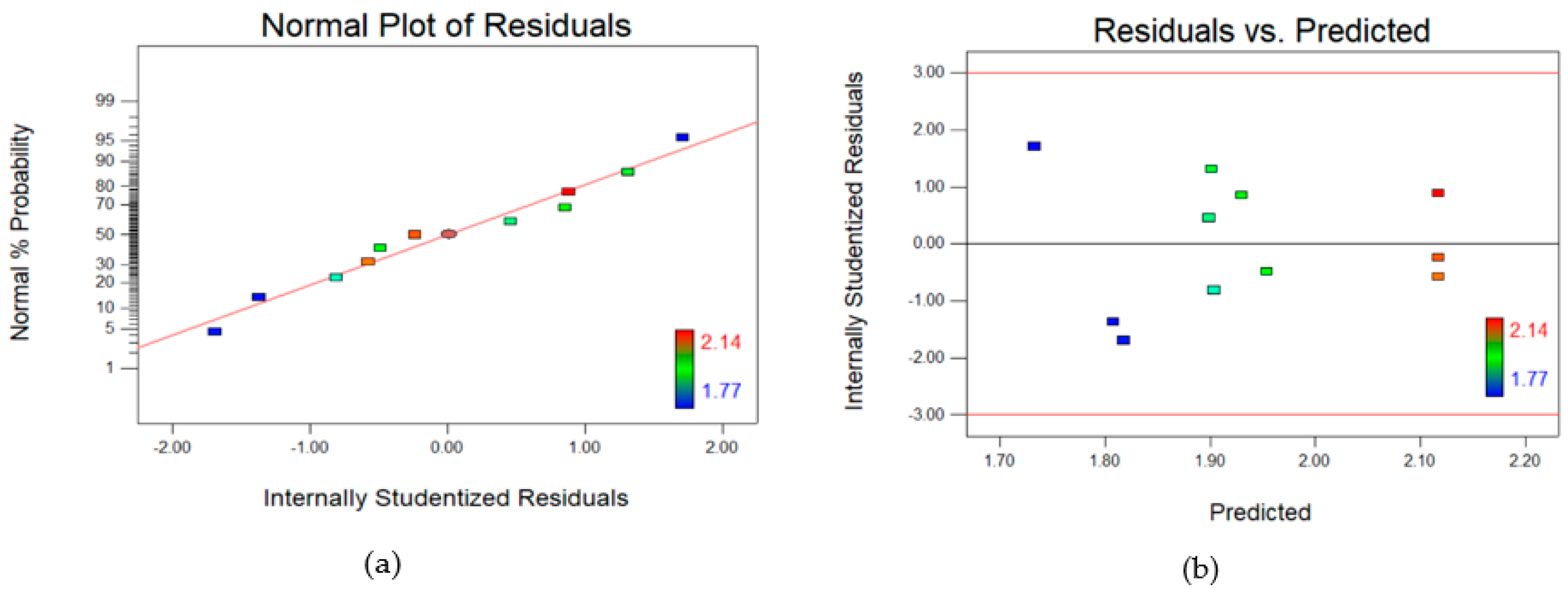

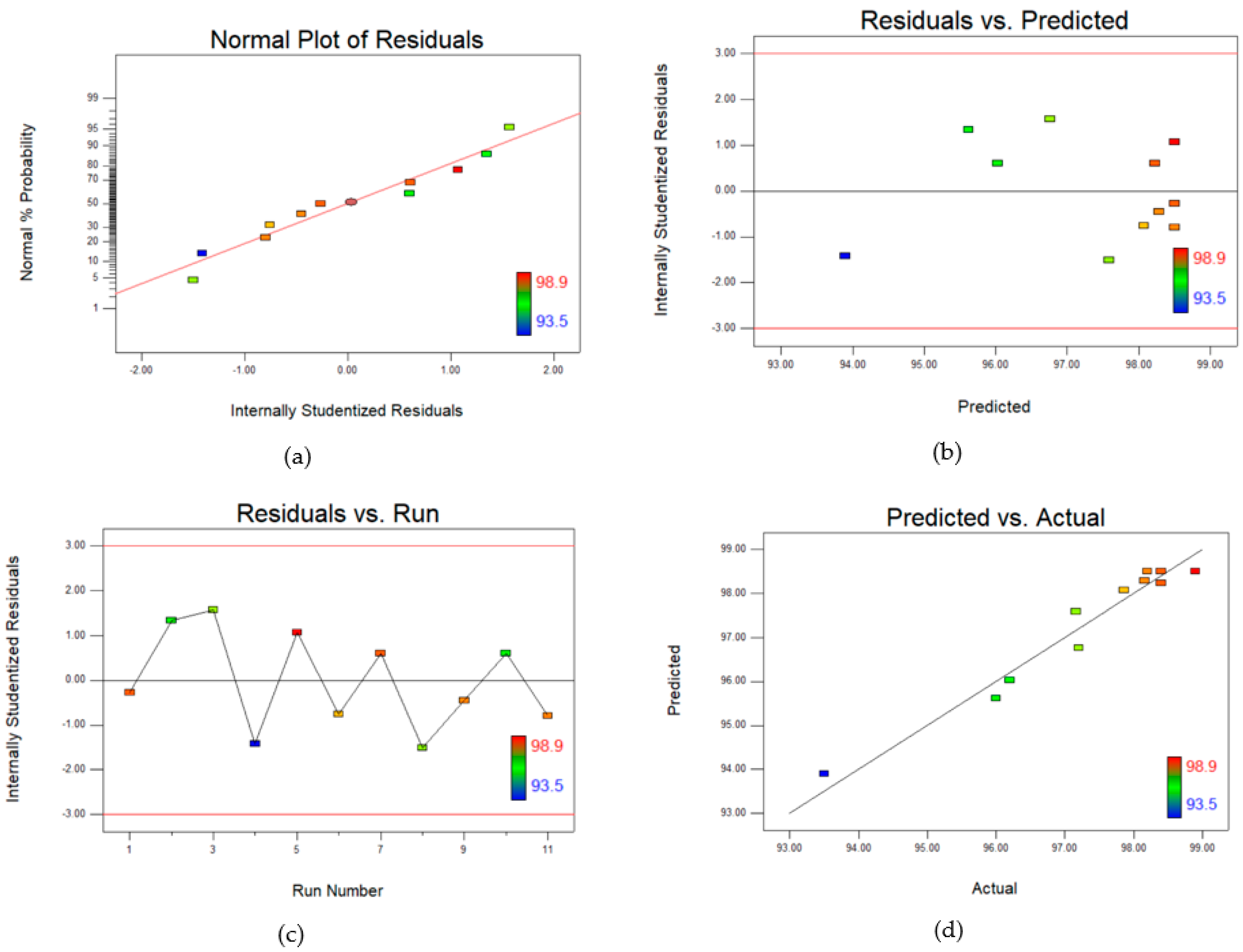
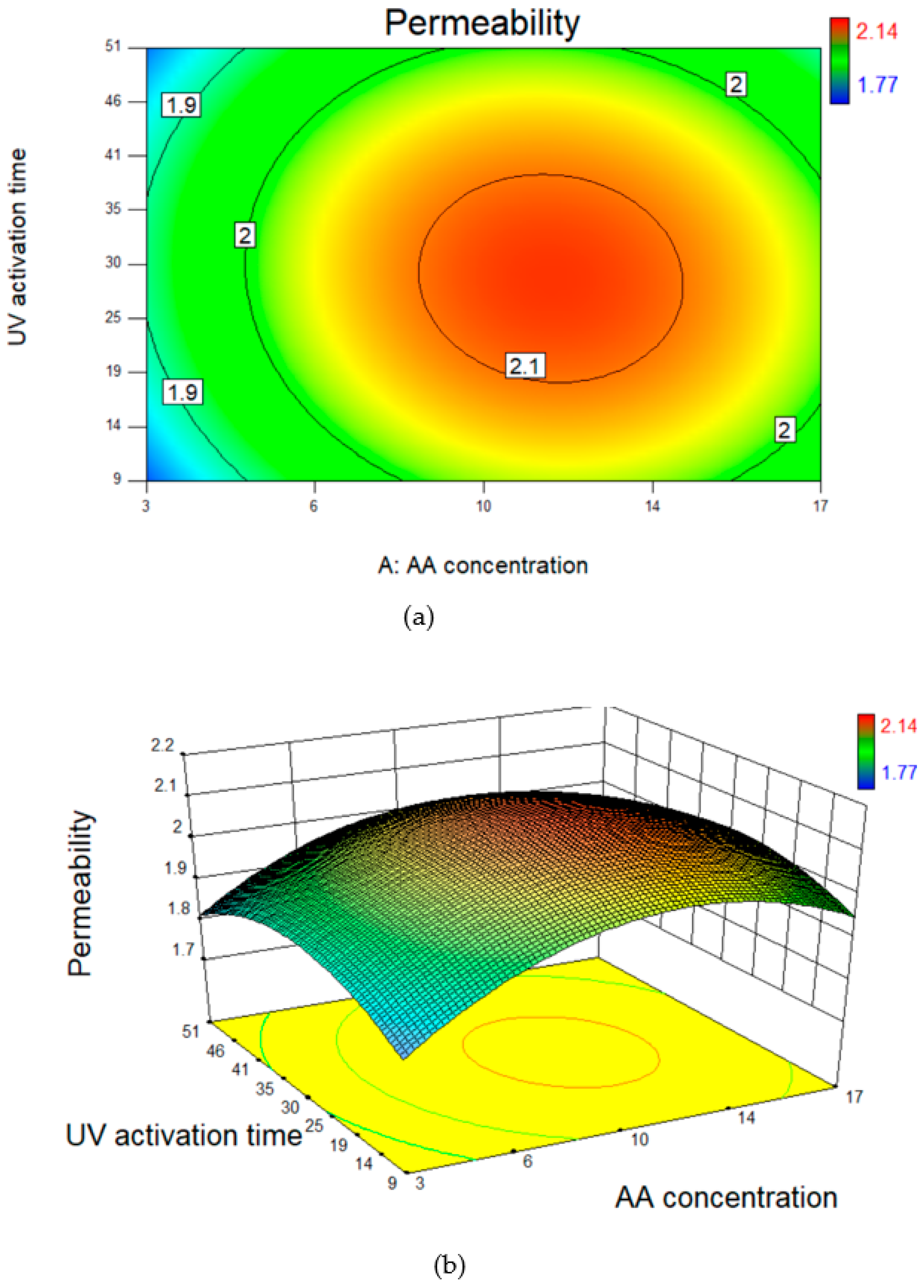


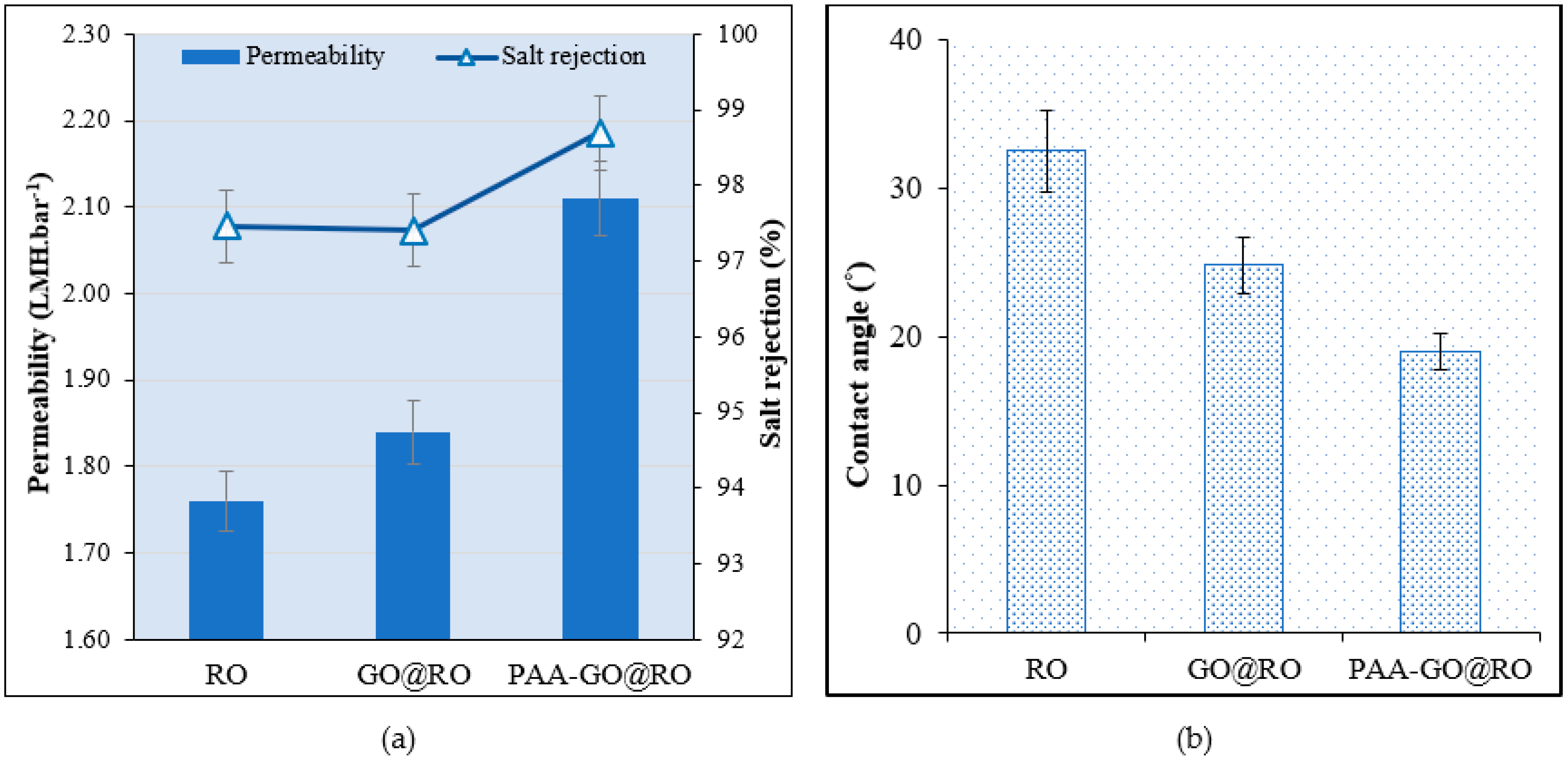
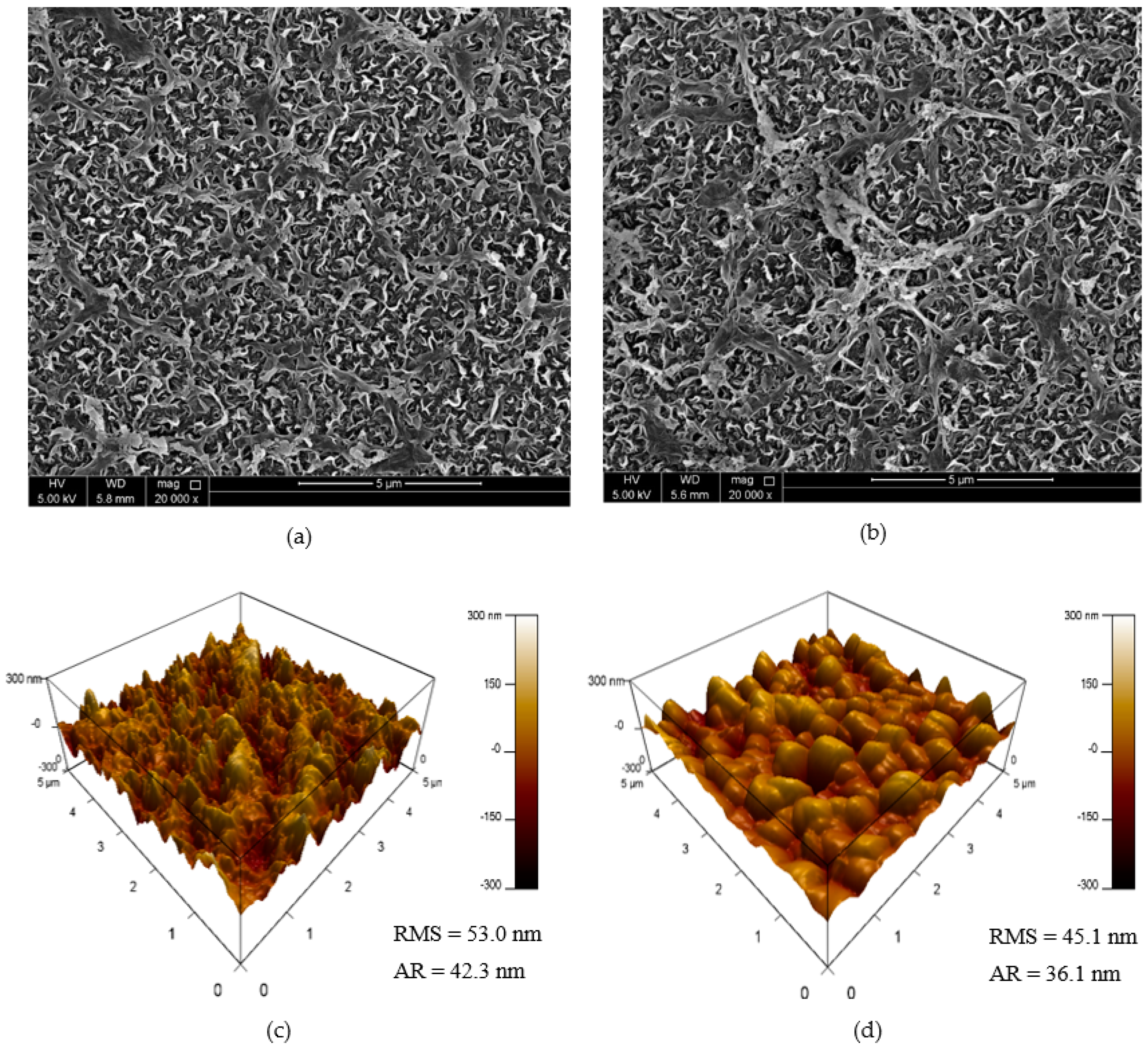
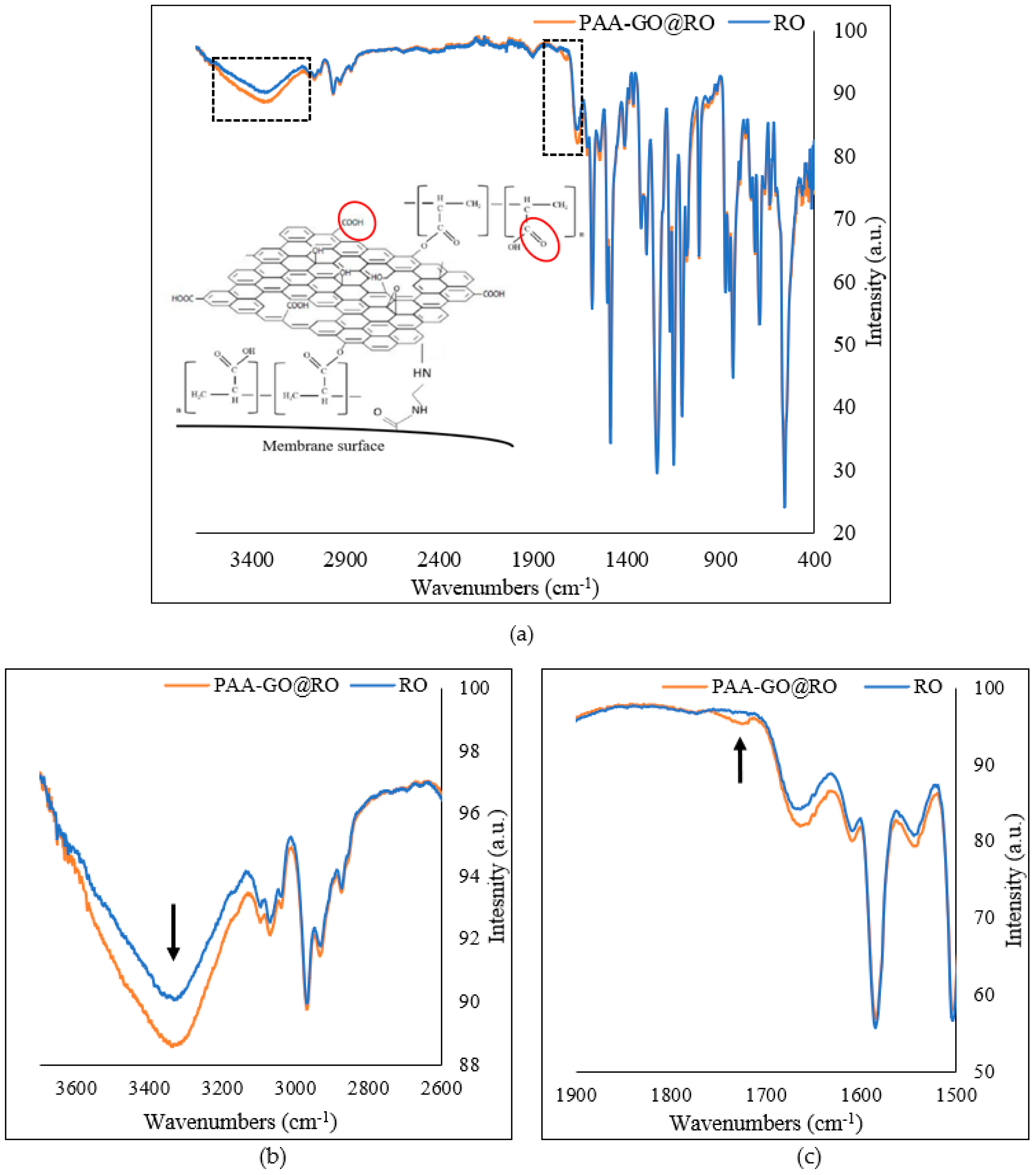
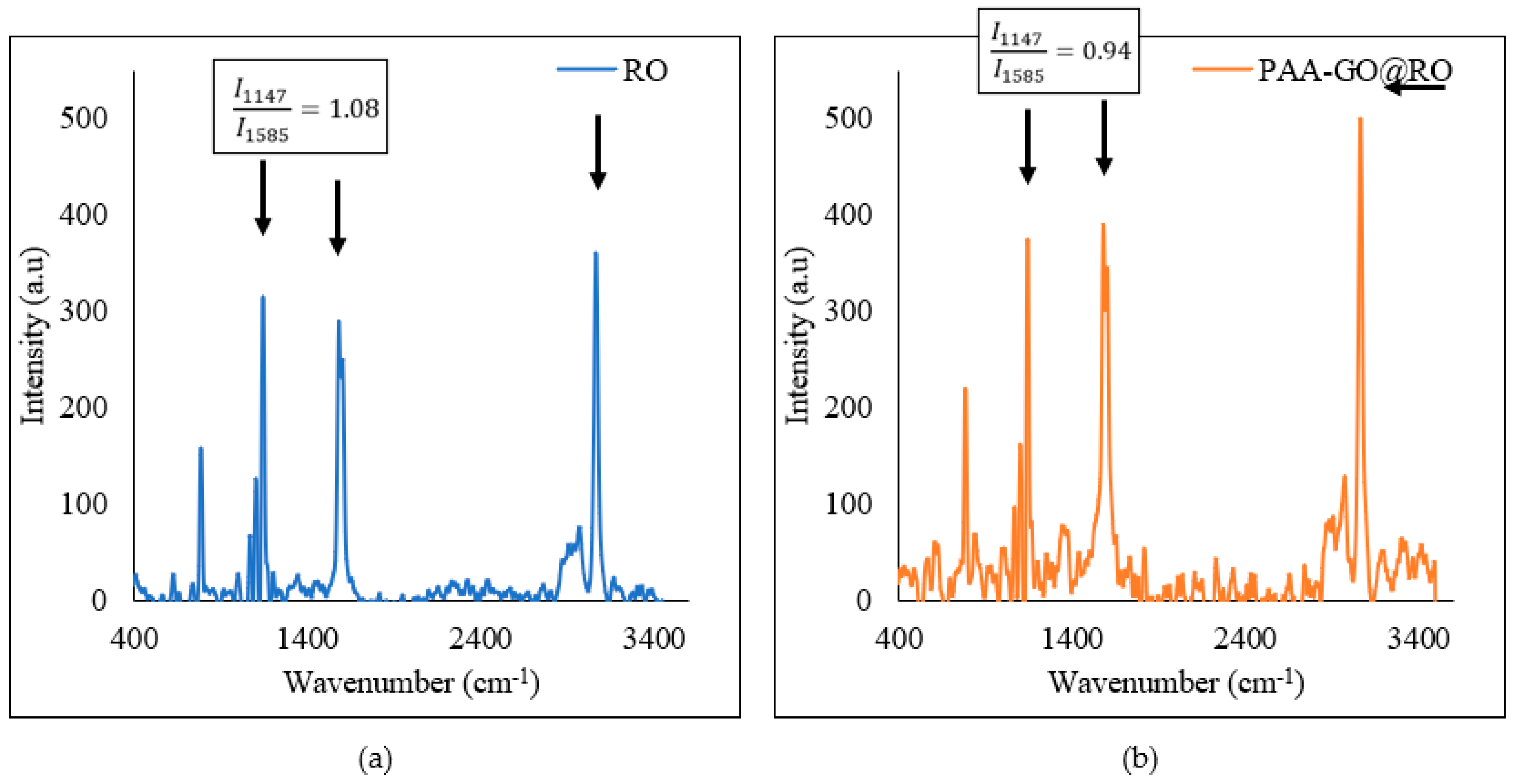

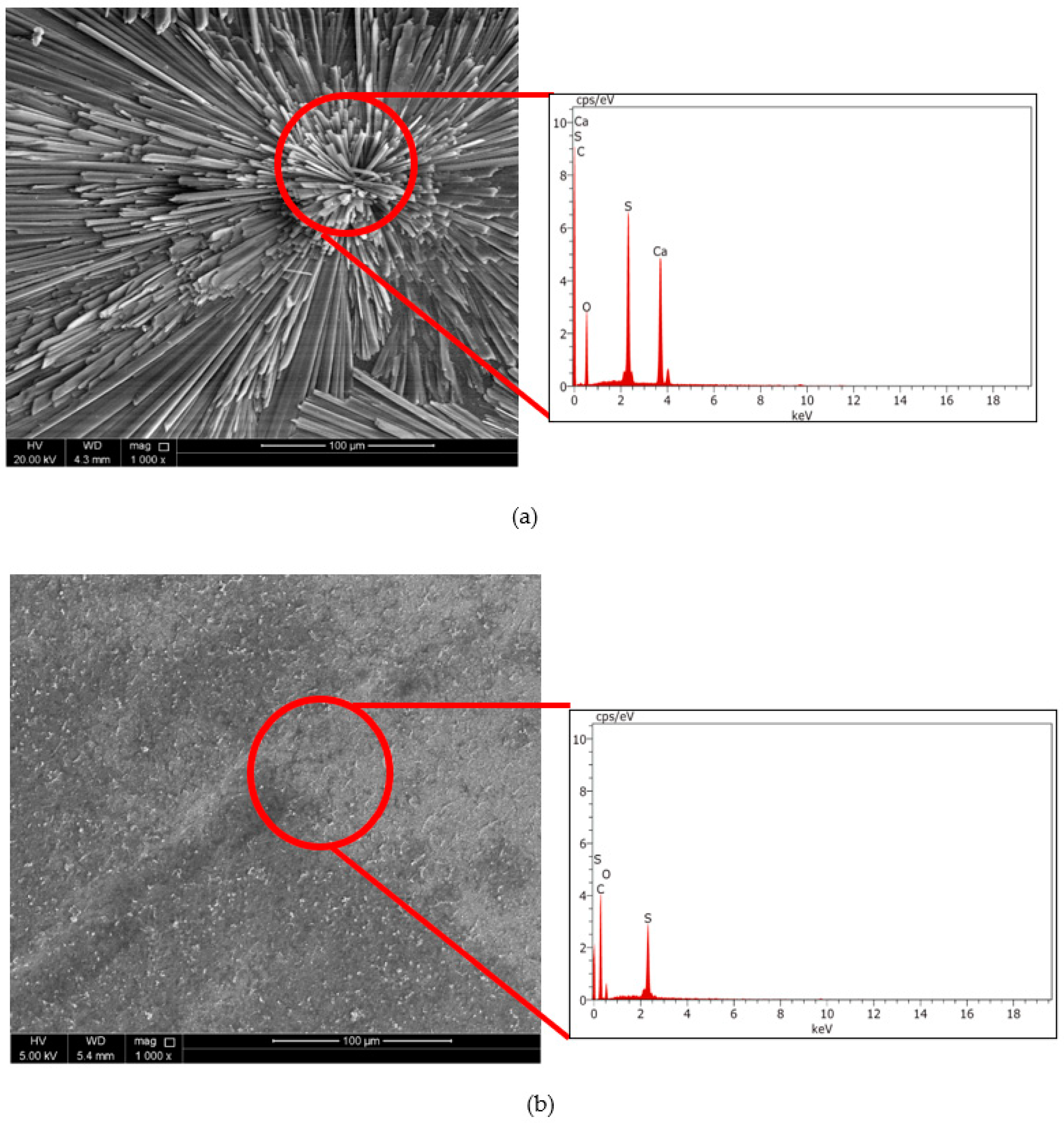
| Factors | Units | Axial Points | Factorial Points | Central Points |
|---|---|---|---|---|
| PAA concentration | mg·L−1 | 0, 20 | 3, 17 | 10 |
| UV radiation time | minutes | 0, 60 | 9, 51 | 30 |
| Run | Factors | Responses | ||
|---|---|---|---|---|
| AA Concentration | UV Activation Time | Permeability | %R | |
| mg·L−1 | Minutes | LMH·bar−1 | % | |
| 0 * | - | - | 1.76 | 97.46 |
| 0 ** | - | - | 1.84 | 97.41 |
| 1 | 10 | 30 | 2.14 | 98.4 |
| 5 | 10 | 30 | 2.11 | 98.9 |
| 7 | 0 | 30 | 1.77 | 98.4 |
| 9 | 20 | 30 | 1.90 | 98.1 |
| 11 | 10 | 30 | 2.10 | 98.2 |
| Run | Factors | Responses | ||
|---|---|---|---|---|
| AA Concentration | UV Activation Time | Permeability | %R | |
| mg·L−1 | Minutes | LMH·bar−1 | % | |
| 1 | 10 | 30 | 2.14 | 98.4 |
| 3 | 10 | 0 | 1.94 | 97.2 |
| 4 | 10 | 60 | 1.93 | 93.5 |
| 5 | 10 | 30 | 2.11 | 98.9 |
| 11 | 10 | 30 | 2.1 | 98.2 |
| Run | Factors | Responses | ||
|---|---|---|---|---|
| AA Concentration | UV Activation Time | Permeability | %R | |
| mg·L−1 | Minutes | LMH·bar−1 | % | |
| 1 | 10 | 30 | 2.14 | 98.4 |
| 2 | 17 | 51 | 1.88 | 96.0 |
| 3 | 10 | 0 | 1.94 | 97.2 |
| 4 | 10 | 60 | 1.93 | 93.5 |
| 5 | 10 | 30 | 2.11 | 98.9 |
| 6 | 17 | 9 | 1.94 | 97.8 |
| 7 | 0 | 30 | 1.77 | 98.4 |
| 8 | 3 | 9 | 1.77 | 97.1 |
| 9 | 20 | 30 | 1.90 | 98.1 |
| 10 | 3 | 51 | 1.78 | 96.2 |
| 11 | 10 | 30 | 2.10 | 98.2 |
| Source | Sum of Squares | df | Mean Square | F-Value | p-Value | Contribution (%) |
|---|---|---|---|---|---|---|
| Model | 0.17 | 5 | 0.035 | 27 | 0.0013 | |
| AA concentration | 0.027 | 1 | 0.027 | 21.1 | 0.0059 | 12.18 |
| UV activation time | 0.0008 | 1 | 0.0008 | 0.63 | 0.4646 | 0.36 |
| AA concentration × UV activation time | 0.0009 | 1 | 0.0009 | 0.70 | 0.4417 | 0.41 |
| AA concentration2 | 0.13 | 1 | 0.13 | 98.1 | 0.0002 | 58.64 |
| UV activation time2 | 0.057 | 1 | 0.057 | 43.8 | 0.0012 | 25.71 |
| Residual | 0.006 | 5 | 0.001 | |||
| Total | 0.2217 | 10 | ||||
| Lack of Fit | 0.005 | 3 | 0.001 | 3.61 | 0.2244 |
| Source | Sum of Squares | Df | Mean Square | F-Value | p-Value | Contribution (%) |
|---|---|---|---|---|---|---|
| Model | 23.148 | 5 | 4.629 | 21.933 | 0.0021 | |
| AA concentration | 0.003 | 1 | 0.003 | 0.014 | 0.9089 | 0.01 |
| UV activation time | 8.129 | 1 | 8.129 | 38.516 | 0.0016 | 34.61 |
| AA concentration × UV activation time | 0.202 | 1 | 0.202 | 0.959 | 0.3723 | 0.86 |
| AA concentration2 | 0.081 | 1 | 0.081 | 0.384 | 0.5625 | 0.34 |
| UV activation time2 | 14.017 | 1 | 14.017 | 66.408 | 0.0005 | 59.68 |
| Residual | 1.055 | 5 | 0.211 | |||
| Total | 23.487 | 10 | ||||
| Lack of Fit | 0.795 | 3 | 0.265 | 2.039416 | 0.3457 |
| Permeability | Salt Rejection | |
|---|---|---|
| R-Squared | 0.964 | 0.956 |
| Adj R-Squared | 0.928 | 0.912 |
| Pred R-Squared | 0.773 | 0.742 |
| Adeq Precision | 14.48 | 13.568 |
| Membrane | Optimized Conditions | RSM Prediction | Desirability | Experimental | |||
|---|---|---|---|---|---|---|---|
| AA Concentration (mg·L−1) | UV Activation Time (min.) | Permeability (LMH·bar−1) | % R (%) | Permeability (LMH·bar−1) | % R (%) | ||
| PAA-GO@RO | 11.48 | 25.66 | 2.12115 | 98.6 | 0.948 | 2.11 | 98.7 |
| Permeability | Salt Rejection | Elemental Composition | Membrane Surface Roughness Parameters | Raman Spectrum | |||||
|---|---|---|---|---|---|---|---|---|---|
| (LMH·bar−1) | % R | C (283 eV) | O (530 eV) | N (398 eV) | O/N | RMS | AR | I1147/I1585 | |
| RO | 1.7 ± 0.1 | 97.4 ± 0.1 | 74.12 | 17.55 | 7.96 | 2.20 | 53.0 | 42.3 | 1.08 |
| PAA-GO@RO (optimized) | 2.1 ± 0.1 | 98.7 ± 0.1 | 73.74 | 24.41 | 7.39 | 3.30 | 45.1 | 36.1 | 0.94 |
Publisher’s Note: MDPI stays neutral with regard to jurisdictional claims in published maps and institutional affiliations. |
© 2022 by the authors. Licensee MDPI, Basel, Switzerland. This article is an open access article distributed under the terms and conditions of the Creative Commons Attribution (CC BY) license (https://creativecommons.org/licenses/by/4.0/).
Share and Cite
Ashfaq, M.Y.; Al-Ghouti, M.A. Optimization of Polyacrylic Acid Coating on Graphene Oxide-Functionalized Reverse-Osmosis Membrane Using UV Radiation through Response Surface Methodology. Polymers 2022, 14, 3711. https://doi.org/10.3390/polym14183711
Ashfaq MY, Al-Ghouti MA. Optimization of Polyacrylic Acid Coating on Graphene Oxide-Functionalized Reverse-Osmosis Membrane Using UV Radiation through Response Surface Methodology. Polymers. 2022; 14(18):3711. https://doi.org/10.3390/polym14183711
Chicago/Turabian StyleAshfaq, Mohammad Yousaf, and Mohammad A. Al-Ghouti. 2022. "Optimization of Polyacrylic Acid Coating on Graphene Oxide-Functionalized Reverse-Osmosis Membrane Using UV Radiation through Response Surface Methodology" Polymers 14, no. 18: 3711. https://doi.org/10.3390/polym14183711
APA StyleAshfaq, M. Y., & Al-Ghouti, M. A. (2022). Optimization of Polyacrylic Acid Coating on Graphene Oxide-Functionalized Reverse-Osmosis Membrane Using UV Radiation through Response Surface Methodology. Polymers, 14(18), 3711. https://doi.org/10.3390/polym14183711








